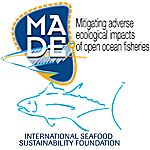The incidental mortality of non-target species is an issue of particular interest in ecosystem-based fisheries management. In Southern Brazil, the pelagic longline fishery for tuna has concentrated between latitudes 22-33S where migratory turtles are caught incidentally. This study aims to show the different patterns detected for major turtle species based on a partial monitoring of fishing operations during the period 2003-2010. Data sampled in 110 fishing trips recorded a total of 1290 sets being mostly of loggerhead turtles (CPUE 0.76) followed by leatherbacks (CPUE 0.16). Almost half of the animals were caught by just 1/5 of the sampled fleet. Species feeding behavior was a factor influencing the site of insertion by the hook. Leatherback turtles were found entangled with a hook externally, while loggerheads were mostly hooked by the mouth. Correlation between the number of animals caught and environmental variables fishing depth, air temperature and SST was significant for the leatherback turtle. Inter-annual variations were significant for both species. Higher catches of loggerheads corresponded to most oceanic fishing areas, mainly close to the Rio Grande Rise, while leatherback's mainly close to the slope. Loggerhead's abundance correlated mostly with cooler and deeper waters. Their carapace lengths ranged 50-70 cm indicating a pelagic juvenile stage of development, possibly in transoceanic migrations. In terms of seasonality, 68% of the animals were caught during autumn (CPUE 1.49) and winter (CPUE 0.94). Overall, the identified patterns will highlight important considerations to EBFM such as critical areas and key operational characteristics to impacts mitigation.
- Presentation

 PDF version
PDF version
